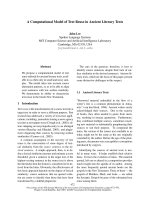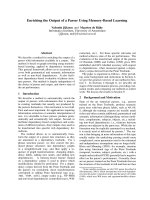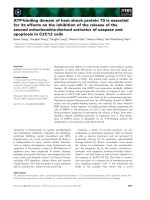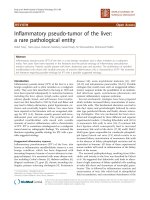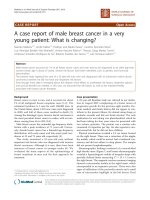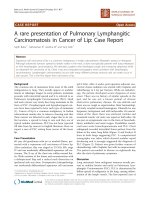Báo cáo khoa học: "Gastric cancer: predictors of recurrence when lymph-node dissection is inadequate" potx
Bạn đang xem bản rút gọn của tài liệu. Xem và tải ngay bản đầy đủ của tài liệu tại đây (159.77 KB, 3 trang )
BioMed Central
Page 1 of 3
(page number not for citation purposes)
World Journal of Surgical Oncology
Open Access
Correspondence
Gastric cancer: predictors of recurrence when lymph-node
dissection is inadequate
Esther Uña
Address: Medical Oncology Service, Clinical University Hospital, Valladolid, Spain
Email: Esther Uña -
Abstract
Background: The TNM classification (sixth edition) requires at least 15 lymph nodes to be
examined to allow an accurate staging. However, in our environment, only 20% of patients have
the recommended minimum of 15 nodes removed.
Purpose: To evaluate clinicopathological predictors of recurrence in patients with gastric cancer
undergoing radical resection with an inadequate number of lymph nodes examined.
Methods: 101 patients were included in this retrospective cohort. We evaluated age, gender,
tumoral location, Borrmann type, Lauren histotype, type of gastrectomy, grade, invasion depth of
tumor, lymph node involvement, ratio between metastatic and total number of excised lymph
nodes keeping 20% as the cutoff value (LNR) and adjuvant treatment. The association between
these variables and recurrence was investigated by using univariate methods and multivariate
logistic regression analysis.
Results: Median (range) age was 63 years (44-85). 63% males, 37% females. Median follow-up time
for the whole patients population was 36 months (10-104). Median number of lymph nodes
retrieved was 6 (0-14). Recurrence: 50 of 101 cases (49,6%); 41 hematogeneus dissemination, 9
locoregional recurrences. The following factors were found to be correlated with the recurrence
risk: tumoral location, invasion depth of tumor, lymph node involvement and LNR. A multivariate
analysis revealed that depth of invasion [odds ratio (OR) 2.80, 95% confidence interval (CI) 1.03-
7.58, P = 0.04] and LNR (OR 2.34, 95% CI 1.05-5.21, P = 0.03) were independent risk factors for
recurrences of gastric cancer. Median time to recurrence: 16 months (2-50). 82% of recurrences
occurred within the first two years after surgical treatment. The estimated cumulative risk of
recurrence at five years: 61% in the whole patients population, with serosal invasion and LNR >
and < 20% was 82% and 44%, without serosal invasion 73% and 39% respectively.
Conclusion: Invasion depth of tumor and LNR were independent predictors of recurrence in
gastric cancer after potentially curative resection with an inadequate number of lymph nodes
examined.
Correspondence
Metastasis of the lymph node (MLN) is one of the most
important prognostic factors in gastric cancer [1].
Although Aurello et al. [2] have indicated that the number
of nodes necessary to conclude N0 may vary according to
the depth of tumor invasion (T), the TNM classification
Published: 17 September 2009
World Journal of Surgical Oncology 2009, 7:69 doi:10.1186/1477-7819-7-69
Received: 26 June 2009
Accepted: 17 September 2009
This article is available from: />© 2009 Uña; licensee BioMed Central Ltd.
This is an Open Access article distributed under the terms of the Creative Commons Attribution License ( />),
which permits unrestricted use, distribution, and reproduction in any medium, provided the original work is properly cited.
World Journal of Surgical Oncology 2009, 7:69 />Page 2 of 3
(page number not for citation purposes)
(International Union Against Cancer, sixth edition)
requires the retrieval and analysis of at least 15 lymph
nodes for accurate staging. However, in most cases, the
number of nodes dissected is smaller and only 20 to 30%
of the patients have the recommended minimum dissec-
tion of 15 nodes.
Although previous studies have indicated that the lymph-
node ratio (LNR), which is defined as the ratio of the
number of MLN to the total number of nodes found dur-
ing pathological examination, is a powerful independent
prognostic factor [3,4] with significant superiority in min-
imizing "stage migration" for patients with more than 15
nodes evaluated, it remains controversial whether this
result is applicable to patients with inadequate staging [5].
Many published studies report different cut offs for LNR,
but the consensus value seems to be 20% [6].
We carried out an institutional retrospective study to
investigate the relationship between classical clinico-
pathological features and LNR (using 20% as the cut off
value) and the prognosis in patients with gastric cancer
who underwent an apparently radical resection but who
had an insufficient number of lymph nodes retrieved
(and, therefore, were inadequately staged).
One hundred and one patients were included in the study
from 2003 to 2006. The median age was 63 years (range,
44-85 years) and 63% of patients were male. The median
follow-up time was 36 months (range, 10-104 months)
and the median number of lymph nodes analyzed was six
(range, 0-14 nodes). Recurrence was detected in 50 out of
101 cases (49,6%), 41 patients presented hematogenous
dissemination as the main location (20 of them presented
also locoregional recurrence with lymph nodes involved
in 13 patients), and nine patients had only locoregional
recurrence (see Table 1). The high recurrence rate
observed in this population could be explained by the
selection process, which was based on limited lymph
node dissection and could lead to an increase in the
likelihood of understaging. Many studies have indicated
that the number of metastatic nodes in patients with rad-
ically resected gastric cancer increases with the number of
lymph nodes removed [7].
The following factors were correlated with the recurrence
risk: tumoral location, invasion depth of the tumor,
lymph-node involvement (pN), and LNR.
A multivariate analysis of our data revealed that depth of
invasion [odds ratio (OR), 2.80; 95% confidence interval
(CI), 1.03-7.58; P = 0.04] and LNR (OR, 2.34; 95% CI,
1.05-5.21; P = 0.03) were independent risk factors for the
recurrence of gastric cancer.
The median time to recurrence was 16 months (range, 2-
50 months). Eighty-two percent of recurrences occurred
within the first two years after surgical treatment. The esti-
mated cumulative risk of recurrence at five years was 61%
in the whole population; in the case of serosal invasion
and LNR > and ≤ 20%, this risk was 82% and 44%, respec-
tively; without serosal invasion, the risk was 73% and
39%, respectively with LNR > and ≤ 20%.
Although we did not apply any specific method to select
the LNR cut off, we nevertheless obtained an interesting
and significant result considering 20% as the cut off most
frequently used. It is clear that the fewer the nodes exam-
ined, the lower was the accuracy of the prognostic system.
Our study revealed that depth of tumor invasion and LNR
with a 20% cutoff value were independent and significant
predictors of recurrence in gastric cancer after potentially
curative resection with examination of an inadequate
number of lymph nodes.
Competing interests
The author declares that she has no competing interests.
References
1. Hidaka H, Eto T, Maehara N, Jimi S, Hotokezaka M, Chijiiwa K: Com-
parative effect of lymph node metastasis classified by the
anatomical site or by the number of nodes involved on prog-
nosis of patients with gastric cancer. Hepatogastroenterology
2008, 55(88):2269-2272.
2. Aurello P, D'Angelo F, Rossi S, Bellagamba R, Cicchini C, Nigri G,
Ercolani G, De Angelis R, Ramacciato G: Classification of lymph
node metastases from gastric cancer: comparison between
N-site and N-number systems. Our experience and review of
the literature. Am Surg 2007, 73:359-366.
Table 1: Specific sites of gastric cancer recurrence in our
population.
Locoregional Number of patients
Lymph nodes 5
Anastomosis 2
Gastric bed 2
Distant Number of patients
Peritoneal carcinomatosis 18
Liver 11
Lung 8
Bones 3
Pleura 1
Publish with BioMed Central and every
scientist can read your work free of charge
"BioMed Central will be the most significant development for
disseminating the results of biomedical research in our lifetime."
Sir Paul Nurse, Cancer Research UK
Your research papers will be:
available free of charge to the entire biomedical community
peer reviewed and published immediately upon acceptance
cited in PubMed and archived on PubMed Central
yours — you keep the copyright
Submit your manuscript here:
/>BioMedcentral
World Journal of Surgical Oncology 2009, 7:69 />Page 3 of 3
(page number not for citation purposes)
3. Xu DZ, Geng QR, Long ZJ, Zhan YQ, Li W, Zhou ZW, Chen YB, Sun
XW, Chen G, Liu Q: Positive lymph node ratio is an independ-
ent prognostic factor in gastric cancer after D2 resection
regardless of the examined number of lymph nodes. Ann Surg
Oncol 2009, 16(2):319-326.
4. Persiani R, Rausei S, Biondi A, Boccia S, Cananzi F, D'Ugo D: Ratio
of metastatic lymph nodes: impact on staging and survival of
gastric cancer. Eur J Surg Oncol 2008, 34(5):519-524.
5. Sun Z, Zhu GL, Lu C, Guo PT, Huang BJ, Li K, Xu Y, Li DM, Wang
ZN, Xu HM: The impact of N-ratio in minimizing stage migra-
tion phenomenon in gastric cancer patients with insufficient
number or level of lymph node retrieved: results from a Chi-
nese mono-institutional study in 2159 patients. Ann Oncol
2009, 20(5):897-905.
6. Siewert JR, Bottcher K, Stein HJ, Roder JD: Relevant prognostic
factors in gastric cancer: ten-year results of the German
Gastric Cancer Study. Ann Surg 1998, 228:449-461.
7. Marchet A, Mocellin S, Ambrosi A, Morgagni P, Garcea D, Marrelli D,
Roviello F, de Manzoni G, Minicozzi A, Natalini G, De Santis F, Baioc-
chi L, Coniglio A, Nitti D, Italian Research Group for Gastric Cancer
(IRGGC): The ratio between metastatic and examined lymph
nodes (N ratio) is an independent prognostic factor in gastric
cancer regardless of the type of lymphadenectomy. Results
from an Italian multicentric study in 1853 patients. Ann of Surg
2007, 245(4):543-552.
